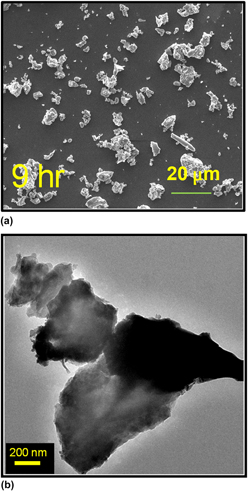Crossref Citations
This article has been cited by the following publications. This list is generated based on data provided by
Crossref.
Qin, X. D.
Zhu, Z. W.
Liu, G.
Fu, H. M.
Zhang, H. W.
Wang, A. M.
Li, H.
and
Zhang, H. F.
2015.
Ultrafast degradation of azo dyes catalyzed by cobalt-based metallic glass.
Scientific Reports,
Vol. 5,
Issue. 1,
Xie, Shenghui
Huang, Ping
Kruzic, Jamie J.
Zeng, Xierong
and
Qian, Haixia
2016.
A highly efficient degradation mechanism of methyl orange using Fe-based metallic glass powders.
Scientific Reports,
Vol. 6,
Issue. 1,
Das, Santanu
Santos‐Ortiz, Reinaldo
Arora, Harpreet Singh
Mridha, Sanghita
Shepherd, Nigel D.
and
Mukherjee, Sundeep
2016.
Electromechanical behavior of pulsed laser deposited platinum‐based metallic glass thin films.
physica status solidi (a),
Vol. 213,
Issue. 2,
p.
399.
Das, Santanu
Garrison, Seth
and
Mukherjee, Sundeep
2016.
Bi‐Functional Mechanism in Degradation of Toxic Water Pollutants by Catalytic Amorphous Metals.
Advanced Engineering Materials,
Vol. 18,
Issue. 2,
p.
214.
Deng, Z.
Zhang, X.H.
Chan, K.C.
Liu, L.
and
Li, T.
2017.
Fe-based metallic glass catalyst with nanoporous surface for azo dye degradation.
Chemosphere,
Vol. 174,
Issue. ,
p.
76.
Xie, Sheng-Hui
Peng, Guang-Qiang
Tu, Xian-Meng
Qian, Hai-Xia
and
Zeng, Xie-Rong
2018.
Fe-Based Powders Prepared by Ball-Milling with Considerable Degradation Efficiency to Methyl Orange Compared with Fe-Based Metallic Glasses.
Acta Metallurgica Sinica (English Letters),
Vol. 31,
Issue. 11,
p.
1207.
Qin, Xindong
Li, Zhengkun
Zhu, Zhengwang
Fu, Huameng
Li, Hong
Wang, Aimin
Zhang, Hongwei
and
Zhang, Haifeng
2018.
Fe-based metallic glass: An efficient and energy-saving electrode material for electrocatalytic degradation of water contaminants.
Journal of Materials Science & Technology,
Vol. 34,
Issue. 12,
p.
2290.
Zhang, X.H.
Zeng, Y.Q.
Yin, L.
Jiang, J.Q.
Pan, Y.
Li, R.
Liu, L.
Li, T.
and
Chan, K.C.
2018.
Formation of micro/nano pits with high catalytic activity on Fe80B20 amorphous alloy.
Corrosion Science,
Vol. 141,
Issue. ,
p.
109.
Zhang, Lai‐Chang
and
Liang, Shun‐Xing
2018.
Fe‐based Metallic Glasses in Functional Catalytic Applications.
Chemistry – An Asian Journal,
Vol. 13,
Issue. 23,
p.
3575.
Qin, Xindong
Li, Zhengkun
Zhu, Zhengwang
Fang, Dawei
and
Zhang, Haifeng
2019.
Fenton-like degradation of coke wastewater using Fe78Si8B14 and Fe73.5Nb3Cu1Si13.5B9 metallic glasses.
Journal of Physics and Chemistry of Solids,
Vol. 133,
Issue. ,
p.
85.
Zhang, Huiyan
Fornell, Jordina
Feng, Yuping
Golvano, Irati
Baró, Maria Dolors
Pellicer, Eva
and
Sort, Jordi
2019.
Inducing surface nanoporosity on Fe-based metallic glass matrix composites by selective dealloying.
Materials Characterization,
Vol. 153,
Issue. ,
p.
46.
Li, Xuelian
Wu, Yuying
Yang, Songtao
Cha, Xingjian
Shao, Pengcheng
and
Wang, Li
2019.
Preparation and degradation property of magnetic FePBCSi amorphous alloy powder.
Journal of Non-Crystalline Solids,
Vol. 503-504,
Issue. ,
p.
284.
Zhang, Lai-Chang
Jia, Zhe
Lyu, Fucong
Liang, Shun-Xing
and
Lu, Jian
2019.
A review of catalytic performance of metallic glasses in wastewater treatment: Recent progress and prospects.
Progress in Materials Science,
Vol. 105,
Issue. ,
p.
100576.
Banerjee, Abesh
Chattopadhyay, Sayan
Kundu, Avirup
Sharma, Rajendra K.
Maiti, Pralay
and
Das, Santanu
2019.
Vertically aligned zinc oxide nanosheet for high-performance photocatalysis of water pollutants.
Ceramics International,
Vol. 45,
Issue. 14,
p.
16821.
Dong, Q.
Song, P.
Tan, J.
Qin, X.M.
Li, C.J.
Gao, P.
Feng, Z.X.
Calin, M.
and
Eckert, J.
2020.
Non-isothermal crystallization kinetics of a Fe–Cr–Mo–B–C amorphous powder.
Journal of Alloys and Compounds,
Vol. 823,
Issue. ,
p.
153783.
Kursun, Celal
Gogebakan, Musa
Eskalen, Hasan
Uruş, Serhan
and
Perepezko, John H.
2020.
Microstructural Evaluation and Highly Efficient Photocatalytic Degradation Characteristic of Nanostructured Mg65Ni20Y15−xLax (X = 1, 2, 3) Alloys.
Journal of Inorganic and Organometallic Polymers and Materials,
Vol. 30,
Issue. 2,
p.
494.
Ramesh, Martha
2021.
N and Fe doped NiO nanoparticles for enhanced photocatalytic degradation of azo dye methylene blue in the presence of visible light.
SN Applied Sciences,
Vol. 3,
Issue. 10,
Aslan, Mikail
Kaya, Abdulaziz
Eskalen, Hasan
Kurşun, Celal
Çeşme, Mustafa
and
Gögebakan, Musa
2024.
Efficient Catalytic Degradation of Azo Dyes from Textile Wastewater by Nano and Micro Amorphous Alloys.
ChemistrySelect,
Vol. 9,
Issue. 7,





